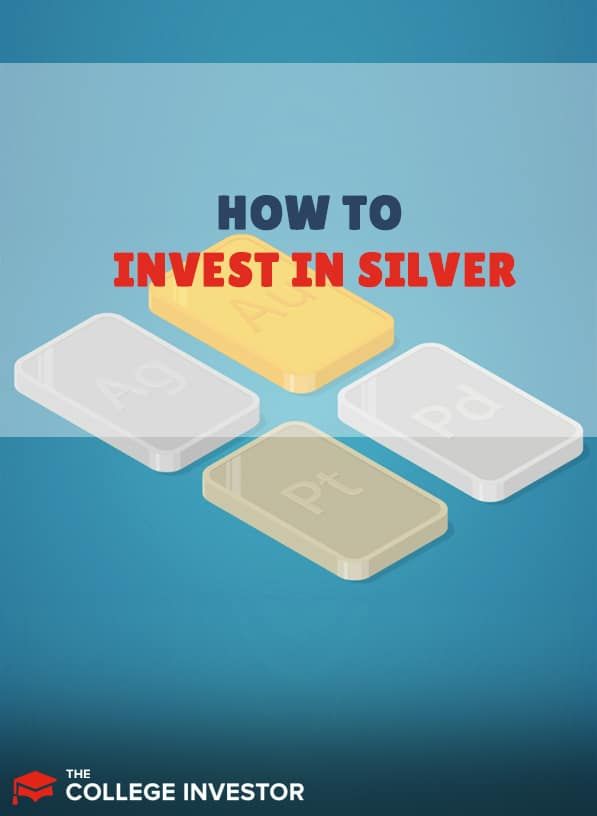
There are multiple ways to invest in silver. Silver is a store of value and is an entirely different type of investment compared to stocks (equities).
Since a stock represents the value of a company, it's value can drop all the way to zero. Silver, however, represents the value of a commodity. This means that it will always have some intrinsic value.
That may sound like a benefit (and it is). However, there are drawbacks to investing in silver such as purchase costs that are often higher than stocks and, in some cases, the hassle of trying to find a place to store your silver safely.
The good news for those who want to invest in silver is that there are ways to maximize the benefits while minimizing the downsides. In this article, we’ll look at a few different ways to invest in silver.
Precious Metal Funds
Choosing to invest in silver through a mutual fund or ETF are two of the easiest ways to get start. But while there are ETFs that invest exclusively in silver (as we'll look at next), this is uncommon for mutual funds. However, there are mutual funds that invest in precious metals as a category. Examples include:
- Invesco Oppenheimer Gold and Special Minerals Fund (OPGSX)
- Franklin Gold and Precious Metal Funds (FKRCX)
- USAA Precious Metals and Minerals Fund (USAGX)
There are many precious metal ETFs to choose from as well. The Aberdeen Standard Physical Precious Metals Basket Shares ETF (GLTR) and Invesco DB Precious Metals ETF (DPB) are two popular options.
Silver ETFs
ETFs are one of the most popular vehicles for investing silver. There’s no special brokerage approval required to invest in silver ETFs. Investing in an ETF is the same as investing in a stock — you simply buy some ETF shares, and now you have a silver position.
SLV is what most ETF investors buy when they decide to invest in silver. Note that unlike a stock, ETFs have an expense ratio. The expense ratio for SLV is 0.5%. An expense ratio is a fee charged to investors by an investment company for managing the ETF.
By investing in SLV, investors don’t have to worry about taking delivery of silver until they hit 50,000 shares. For most, this isn’t ever going to present a problem.
Commodity ETF Tax Consequences
Commodity ETFs have some special tax consequences that should be taken into consideration. SLV falls into the commodity ETF category. SLV is backed by real silver, which is a commodity. The IRS treats taxation on SLV as if you were holding real silver.
When selling an ETF that you’ve held for over a year, you usually pay long-term capital gains taxes, which max out at 20%. However, commodity ETFs are taxed the same as collectibles. For SLV, the maximum long-term capital gains rate is 28% instead of 20%. However, people with lower incomes won’t be taxed this high and, in some cases, may not be taxed at all.
To find out how much you’ll be taxed (or taxed at all), check the Schedule K-1 or Form 1099-B that you receive from your broker. Taxes are a complex topic since each person’s situation is different. It may be best to work with a tax advisor to determine your taxes due on commodity ETF gains.
Silver Miner ETFs
Silver miners allow you to gain exposure to silver indirectly and there’s no delivery of silver to worry about. Silver miners are a business, which adds another level of complexity and risk and top of investing in silver.
Additionally, the silver mining business is tied to the performance of silver. If the price of silver goes down, silver miner investments will go down too. This isn’t a 1:1 relation, though. If silver goes down by 10%, miners could go down by 5% or 20%.
You can invest in silver miners using the SIL ETF. You can also invest in junior silver miners (which riskier) through the SILJ ETF.
If you're willing to venture to even higher levels of risk, you can invest in the individual silver mining stocks. Just keep in mind that an ETF spreads risk across several companies while investing in individual miners provides no diversification.
Futures And Options
Using futures or options to invest in silver are more advanced techniques than some of the others we’ve talked. You should also know that your brokerage account will need to be approved for trading futures and options before you can get started.
Futures are contracts that trade at the spot price for silver. The spot price is what the going rate for some weight of silver is at that time. Usually, spot is based on one ounce of silver. Trading futures is the closest you can get to the actual price of silver.
A futures contract allows you to speculate on the price of silver or take delivery of physical silver. If you let the futures contract expire, you’ll have to take delivery. For most people, they avoid delivery by selling their contracts before they expire.
Futures and options use more leverage than stocks and ETFs. You have to be very careful when trading these leverage instruments. Silver-based options contracts are derivatives on silver ETFs. Silver futures options contracts are derivatives on the silver futures contract.
When it comes to futures options, you are traded a leveraged instrument on a leveraged instrument! With silver ETF options, they can expire worthless. When this happens, the investor simply loses their investment and doesn’t take delivery of silver.
Bullion
Bullion is physical silver in the form of coins, bars, or ingots. There are a couple of ways to buy bullion silver. Some local coin, pawn, or jewelry shops sell silver bullion. You can also purchase from online sellers of bullion, although this will incur (sometimes expensive) shipping costs.
Silver Bullion is usually marked with symbols such as “Sterling” (92.5% silver) or “0.9999”. These markings help authenticate the silver. The .9999 means that the bullion is 99.99% silver.
You can look at a company like Apmex to buy silver bullion.
Final Thoughts
Choosing to invest in silver can be a great way to diversify your investments. But since silver is just one subset of one investing category (precious metals), you'll want to limit your silver investing to a small percentage of your overall portfolio.
There are many ways to invest in silver and the one you choose is up to you. There isn’t really a right or wrong choice. It comes down to the investment method you're most comfortable with. If you decide you want to use a mutual fund or ETF, here are some of the best brokers that offer low-cost trading.

Robert Farrington is America’s Millennial Money Expert® and America’s Student Loan Debt Expert™, and the founder of The College Investor, a personal finance site dedicated to helping millennials escape student loan debt to start investing and building wealth for the future. You can learn more about him on the About Page or on his personal site RobertFarrington.com.
He regularly writes about investing, student loan debt, and general personal finance topics geared toward anyone wanting to earn more, get out of debt, and start building wealth for the future.
He has been quoted in major publications, including the New York Times, Wall Street Journal, Washington Post, ABC, NBC, Today, and more. He is also a regular contributor to Forbes.
Editor: Clint Proctor Reviewed by: Ashley Barnett
